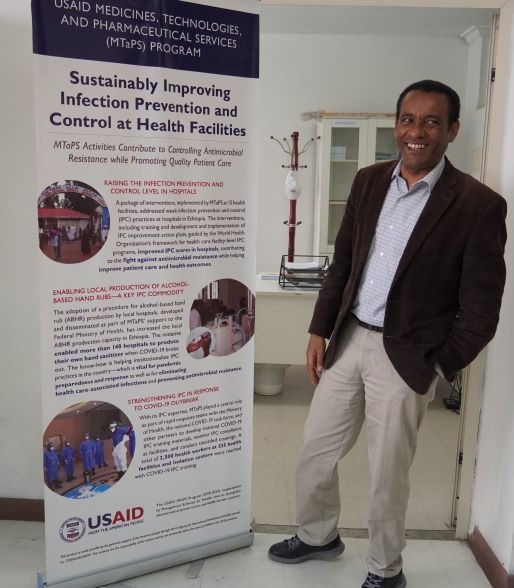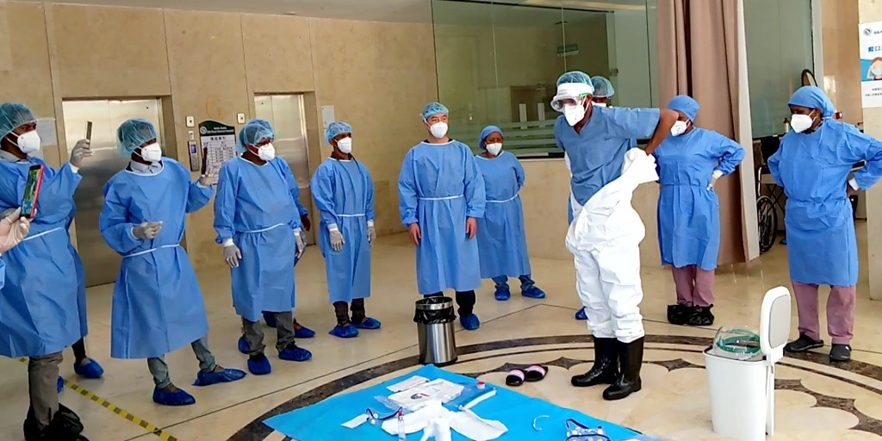Strengthening Capacity for Prevention and Containment of Antimicrobial Resistance in Ethiopia: Q&A with Hailu Tadeg

Hailu Tadeg at the MTaPS Ethiopia office Photo Credit: Jennifer Gardella/MSH
Interview with MTaPS Ethiopia Country Project Director Hailu Tadeg
Q: Ethiopia is one of the countries where the USAID MTaPS Program has worked toward Resilient Pharmaceutical Systems for Better Health in the past five years. What are some of the country program’s significant achievements and milestones toward ensuring that people can access and properly use quality, affordable, effective, and safe medical products and services?
A: The scope of MTaPS in Ethiopia is mainly focused on the prevention and containment of antimicrobial resistance (AMR), covering three technical areas: multisectoral coordination, infection prevention and control, and antimicrobial stewardship, all contributing toward building resilient pharmaceutical systems for better health.
To give you some background, by the time MTaPS landed in Ethiopia, the way the AMR was managed was not optimal to garner the full participation of the key actors. The national regulatory authority was leading national AMR coordination instead of the Ministry of Health (MOH). One of the most significant changes MTaPS advocated for in this area was the successful conversation between the ministry and regulatory authority, which led to transitioning the national leadership role to the MOH.
The move was the foundation for all other progress made in the country, starting with the establishment of a fully staffed secretariat at MOH and the creation of a national governance structure with three layers: first, the high-level, inter-ministerial committee, which focuses on more than just AMR, covering One Health issues like pandemic response, animal health, and environmental issues; next, the National Antimicrobial Resistance Advisory Committee, dedicated to AMR-related issues; and finally, six technical working groups (TWGs), including the antimicrobial stewardship TWG and the infection prevention and control TWG.
The governance structure created an enabling environment for the revision of the national AMR strategy in the context of the national and global recommendations of following a One Health approach. Stakeholders from multiple sectors were involved in the review process to account for One Health needs.
Following launch of the strategy, MTaPS supported the ministry and multisectoral stakeholders to advance implementation at various levels. MTaPS supported resource mobilization which led to the award of USD 1,000,000 by the UN Funding Mechanism to the MOH, WHO, and FAO and became instrumental in supporting implementation of the national action plan.
With regard to infection prevention and control, again, Ethiopia was behind compared to global expectations when MTaPS started. The result of joint external evaluation (JEE) in 2016 indicates Ethiopia scored 2 in infection prevention areas. MTaPS led the review of the foundational materials available to support the infection prevention and control infrastructure at all levels. This was followed by updating of the guidelines, development/adaptation of infection prevention and control monitoring tools, and development and implementation of training materials.
The results of training health workers in more than 30 hospitals were highly impactful! There was a significant improvement in infection prevention and control practices in those hospitals. That was quite timely as when the COVID-19 pandemic struck in 2020, those facilities were the ones readily available to serve as treatment sites.
Q: That seems like a great segue to the next question about pandemic preparedness. A significant period of the implementation of this program was during the COVID-19 pandemic. How did this work lay the foundation for readiness to respond, and what were the lessons COVID-19 carried for the program?
A: At the start of the pandemic, MTaPS was the only USAID partner project that supported the government in the response to COVID-19. Fortunately, because of the prior work of MTaPS, there had already been some progress in infection prevention practices, which aided implementation of the government’s COVID-19 response as hospitals were better equipped to prevent COVID-19 infection at facility level.

Health worker infection prevention and control training Photo Credit: USAID MTaPS Ethiopia
Moreover, in line with our foundational goal of building pharmaceutical systems for better health, MTaPS supported the development of more than 19 guidelines, standard operating procedures (SOPs), and manuals, seconding more than 11 consultants across the country to train staff and implement the guidelines in the hospitals and respond to the pandemic. As partnership is one of the guiding principles of our work, these efforts were in direct support to the MOH, regional health bureaus, and the Ethiopian Public Health Institute.
Results began to show during the very early days of COVID-19. Responding to a shortage of supplies including alcohol-based hand sanitizer to prevent infection, MTaPS led a locally implemented solution. We worked with MOH to develop SOPs and train the pharmacists to produce alcohol-based hand sanitizer in more than 140 hospitals. As a result, they not only were able to cover their own needs, but also supplied it for the surrounding communities. The substantial contribution of this effort to infection prevention and health worker and patient safety was recognized and acknowledged by the clients and government.
Q: While MTaPS has laid the foundation for pharmaceutical systems strengthening and been instrumental in some progress in Ethiopia, what are some of the prevailing challenges that future efforts must address?
A: Due in great part to the support of USAID through MTaPS, and always in partnership with the government and other partners, tools are available, including strategic plans, guidelines, manuals, training materials―the national-level infrastructure for addressing AMR is well laid out.
Yet, everything boils down to what you can do at the health facility level—because most of the infections happen there—and the community level. So, what you are able to implement in those sites is going to determine success in terms of containing and preventing AMR.
As I said, there has been significant progress in multisectoral coordination: multisector stakeholders have even developed their own action plans. The Environmental Protection Authority, for instance, has its own action plans, and AMR is streamlined already into its routine activities. This was a fantastic feat as environmental health has never been involved in AMR prevention and control—the same has happened in Ministry of Agriculture.
But at the facility level, MTaPS selected a few facilities to serve as models and implemented select interventions, like antimicrobial stewardship and infection prevention and control-based quality improvement programs toward improving quality of care. We introduced some interventions over a few months at surgical wards to improve use of antimicrobials because it’s one of the critical gaps now, and to improve compliance with hand-washing practices.
In that short period of time, we witnessed substantial progress in terms of optimizing the use of antimicrobials and even preventing infections. The results were striking for some of the hospitals—those practices ought to be used as models for other facilities. Recently, during an experience-sharing meeting to exchange best practices and experiences amongst hospitals regarding implementation of antimicrobial stewardship and infection prevention and control-based quality improvement programs and outcomes, the government committed to taking over the initiative, including those at MTaPS-supported facilities, and scaling up to more facilities. Some preparatory work has already begun at some facilities.
These are some great examples, but in Ethiopia, we are talking about more than 400 hospitals, 3,000 health centers, and more than 10,000 health posts. So, this is a challenge that still requires considerable effort in the future.
Q: You mentioned plans for the Government of Ethiopia to take on, expand, and scale up some of the efforts initially introduced by USAID through MTaPS. What are some of the strategies that MTaPS has employed to ensure the sustainability of all the work and progress that has been made?
A: To ensure sustainability of what we have done in addressing AMR, one of our key guiding principles in all activities we implement in partnership with the government is that the government takes the lead. Government counterparts are, therefore, well-informed about the activities, strengthen capacity over time, and become strong enough to continue through the existing, ideally somewhat stronger, system. Essentially, the governance structure, tools, and people remain even after MTaPS―that’s an important tool of sustainability.
The trainings, for instance, are all now in the fifth year and have been institutionalized by the government. We have developed an e-module version for the two key face-to-face training programs (IPC and AMS), which were uploaded to MOH website in July 2023, making them available online to all, wherever they are.
The other important milestone that drives sustainability is that the key indicators related to AMR and infection prevention and control are already included in the District Health Information Software 2. What exactly does that mean? Well, the MOH will now receive routine reports on these indicators from the facilities. Moreover, AMR and related issues are already part of many government policy documents, including the health sector transformation plan, and will be part of the national-level policy currently under review. All this points to institutionalization of what we have done so far, which we believe will contribute to sustainability.
Q: As the MTaPS Ethiopia chapter comes to a close, what do all of these achievements mean for both MSH’s legacy in Ethiopia as well as the people of Ethiopia more broadly? How do you hope this work has and will continue to improve the health of people throughout Ethiopia?
A: One of the important decisions we made as a program during implementation of activities was to support the results of our work by generating evidence-based documents and availing the data to all who want them, whenever they want them, both within and outside of Ethiopia, even in the absence of MTaPS. And there are opportunities to continue the momentum that we have achieved so far to maintain the continuity of this work.
MSH has, in Ethiopia, a credible history of leaving a legacy throughout many projects. The contributions MSH has made in the pharmaceutical sector, in the area of supply chain and pharmaceutical systems strengthening, is clear and evident―the impact is deeply felt. For example, one of the innovative pharmaceutical system solutions, Auditable Pharmaceutical Transactions and Services—that MSH introduced from inception to piloting and scale up years back through the SIAPS program—remains a flagship program by the Ethiopian government and USAID. These accomplishments are indicative of MSH’s capabilities in those technical areas and the impact that MSH has made in Ethiopia. That’s the legacy we’ve had in the past, and all we have discussed gives me more confidence to hope we’ll have the same lasting impact after MTaPS ends.